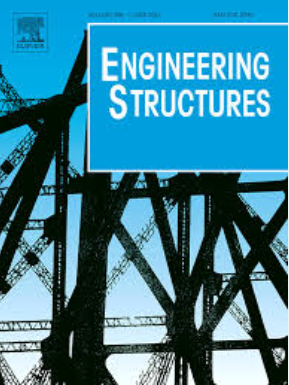采用谱一致易损性引信和非线性危害对不符合规范的钢筋混凝土框架进行地震风险评估
IF 6.4
1区 工程技术
Q1 ENGINEERING, CIVIL
引用次数: 0
摘要
由于结构的非均质性和场地特定危险条件的复杂相互作用,钢筋混凝土框架的地震风险评估面临着巨大的挑战。本研究旨在引入一个新的框架,该框架集成了三个关键概念,专门针对这些挑战。该方法的核心是脆弱性保险丝,它采用三重曲线——下界、中值和上界——严格量化抗震性能的类内可变性,与传统的单曲线方法相比,提供了更细致入微的不符合规范的建筑行为表示。与此相补充的是,光谱一致性转换动态调整脆弱性曲线,以考虑区域光谱形状和土壤类别,通过协调灾害强度与当地岩土条件,确保特定地点的准确性。为了进一步提高精度,该框架采用了一种非线性风险模型,该模型捕获了对数-对数空间中风险曲线的曲率,克服了线性近似的过度简化,显著提高了对罕见、高强度事件的风险估计。应用于具有不同几何形状和材料特性的四种RC框架类型(2-5层),该框架通过非线性危害建模显示风险估计误差降低了15 - 40% %,而光谱一致性调整显示在不同土壤类别中超过概率的可变性高达30% %。脆性融合进一步突出了结构异质性的影响,较旧的非延性框架在性能上表现出25 %的置信区间。最后,提出了四种框架类型的风险图,利用非线性风险曲线和频谱一致的脆弱性融合,考虑局部影响和类型内变异性。本文章由计算机程序翻译,如有差异,请以英文原文为准。
Seismic risk assessment of code-noncompliant reinforced concrete frames using spectrum-consistent fragility fuses and nonlinear hazard
Seismic risk assessment of code-noncompliant reinforced concrete (RC) frames faces significant challenges due to structural heterogeneity and the complex interplay of site-specific hazard conditions. This study aims to introduce a novel framework that integrates three key concepts specifically targeting these challenges. Central to the methodology are fragility fuses, which employ a triplet of curves—lower bound, median, and upper bound—to rigorously quantify within-class variability in seismic performance, offering a more nuanced representation of code-noncompliant building behavior compared to conventional single-curve approaches. Complementing this, spectrum-consistent transformations dynamically adjust fragility curves to account for regional spectral shapes and soil categories, ensuring site-specific accuracy by reconciling hazard intensity with local geotechnical conditions. Further enhancing precision, the framework adopts a nonlinear hazard model that captures the curvature of hazard curves in log-log space, overcoming the oversimplifications of linear approximations and significantly improving risk estimates for rare, high-intensity events. Applied to four RC frame typologies (2–5 stories) with diverse geometries and material properties, the framework demonstrates a 15–40 % reduction in risk estimation errors through nonlinear hazard modeling, while spectrum-consistent adjustments show up to 30 % variability in exceedance probabilities across soil classes. Fragility fuses further highlight the impact of structural heterogeneity, with older, non-ductile frames exhibiting 25 % wider confidence intervals in performance. Finally, risk maps are presented for the four frame typologies, making use of non-linear hazard curves and spectrum-consistent fragility fuses accounting for both local effects and within-typology variability.
求助全文
通过发布文献求助,成功后即可免费获取论文全文。
去求助
来源期刊

Engineering Structures
工程技术-工程:土木
CiteScore
10.20
自引率
14.50%
发文量
1385
审稿时长
67 days
期刊介绍:
Engineering Structures provides a forum for a broad blend of scientific and technical papers to reflect the evolving needs of the structural engineering and structural mechanics communities. Particularly welcome are contributions dealing with applications of structural engineering and mechanics principles in all areas of technology. The journal aspires to a broad and integrated coverage of the effects of dynamic loadings and of the modelling techniques whereby the structural response to these loadings may be computed.
The scope of Engineering Structures encompasses, but is not restricted to, the following areas: infrastructure engineering; earthquake engineering; structure-fluid-soil interaction; wind engineering; fire engineering; blast engineering; structural reliability/stability; life assessment/integrity; structural health monitoring; multi-hazard engineering; structural dynamics; optimization; expert systems; experimental modelling; performance-based design; multiscale analysis; value engineering.
Topics of interest include: tall buildings; innovative structures; environmentally responsive structures; bridges; stadiums; commercial and public buildings; transmission towers; television and telecommunication masts; foldable structures; cooling towers; plates and shells; suspension structures; protective structures; smart structures; nuclear reactors; dams; pressure vessels; pipelines; tunnels.
Engineering Structures also publishes review articles, short communications and discussions, book reviews, and a diary on international events related to any aspect of structural engineering.
 求助内容:
求助内容: 应助结果提醒方式:
应助结果提醒方式:


